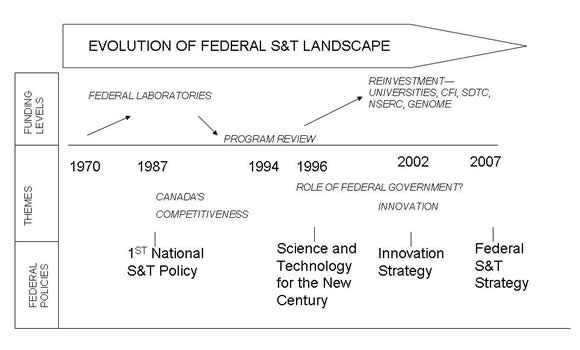Observations - Positioning Natural Resources Canada’s Science and Technology in the Innovation System
Observations
International
Innovation systems are complex, interrelated, continuously evolving and one size does not fit all.
Today’s innovation system has a more diverse and demanding set of stakeholders—the scientific community, government, business sector and civil society—who expect faster and more concrete responses.
NRCan studied innovation systems in Australia, China, Finland, France, Israel, Japan, New Zealand, the United Kingdom, and the United States, as well as, more broadly, in the OECD. The purpose of this analysis was to learn from these countries and to identify any best practices that could be applied at NRCan.
All countries face similar economic and social challenges. For example, demographic changes are causing complex and far-reaching societal, economic and geo-political pressures that will have a profound impact on the strength and capacity of innovation systems. Like Canada, other countries are already experiencing, or will soon experience, a shortage of highly qualified personnel. Nonetheless, each country has responded with its own unique combination of national S&T strategy, funding, tax measures and streamlined regulations to create favourable conditions for innovative S&T. There is much at stake since countries that are able to forecast and quickly exploit opportunities arising from societal demands, or from S&T with applications that are not initially obvious, will be more successful and will develop competitive advantage.
Finland’s success is based on flexibility: the public and private sectors have been able to adjust and take advantage of opportunities afforded by the new techno-economic environment. Intense inter-organizational cooperation is an essential feature of the Finnish innovation system. Support for industrial and sectoral R&D, regionalization, and significant structural and operational changes at universities have been key to the government’s R&D growth strategy.
The role of government and the ways in which institutional structure can maximize S&T investment were also reviewed. Findings include:
- A top-down approach in which government sets the direction is favoured.
- Governments are increasing their involvement in S&T to:
- support fundamental research; and
- serve and support public good;
- Line departments rarely perform S&T—specialized organizations have been created for this purpose;
- Decisions on direction and funding are clearly separated from the performance of S&T; and,
- The three pillars — industry, academia, and government — of the innovation system work in close collaboration.
National
Figure 1: Evolution of Federal S&T Landscape

Text version for Figure 1
Figure 1
The Canadian federal Science and Technology landscape has had a complex evolution that spans decades. It is characterized by changes in funding levels and the examination of various facets of Canada’s innovation system through the release of federal Science and Technology policies in 1987, 1996, 2002 and 2007. Since 1996, there has been a significant shift of Science and Technology funding to universities, industry or collaborative research mechanisms.
The federal S&T community is composed of central agencies, science-based departments and agencies and horizontal committees, each with specific roles and responsibilities. The Canadian federal S&T landscape has had a complex evolution, extending over decades and involving numerous national and international stakeholders.
(See Figure 1). It has also been a catalyst for change in several science-based departments and agencies. For example, Agriculture and Agri-Food Canada, Defence Research and Development Canada, Fisheries and Oceans Canada, Environment Canada, and the National Research Council have recently prepared S&T strategies to re-align, re-focus and reorganize science within their organizations. The strategies address three key concerns: S&T governance systems and structures; ensuring access to a highly skilled workforce; and effective collaboration and stakeholder engagement.
Senior political officials and public servants need to embrace a vision of a linked S&T system and champion collaboration to ensure that it is adopted as a fundamental component of government S&T culture. Leading by example, they should demonstrate that collaboration is not a “corner of the desk” endeavour constituting “extra” work.
CSTA, LINKS, 2005
In recent years, the advisory community, comprised of the Advisory Council on S&T, the Council of S&T AdvisorsFootnote1 and the Council of Canadian Academies, has also influenced the federal response to S&T as well as the work of the Office of the National Science Advisor, and key federal S&T committees and boards. The advisory community helped form the core of federal S&T initiatives and helped guide the ongoing transformation of federal S&T and the innovation system.
NRCan’s evolution will continue to be influenced by the federal S&T landscape and the federal S&T community.
Page details
- Date modified: